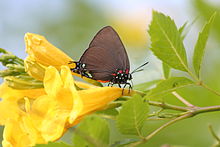Great Purple Hairstreak
Atlides halesusSummary 7
The Great Purple Hairstreak (Atlides halesus), also called the Great Blue Hairstreak, is a common gossamer-winged butterfly species in parts of the United States. It is actually a Neotropical species; its North American range only includes the warm-temperate and subtropical parts of that continent, and it ranges southwards almost to the Isthmus of Panama. The type specimen, however, was shipped to Europe from the Colony of Virginia, probably around the time of the United States Declaration...
Great purple hairstreak 8
The great purple hairstreak (Atlides halesus), also called the great blue hairstreak, is a common gossamer-winged butterflyspecies in parts of the United States. It is actually a Neotropical species; its North American range only includes the warm-temperate and subtropical parts of that continent, and it ranges southwards almost to the Isthmus of Panama. The type specimen, however, was shipped to Europe from the Colony of Virginia, probably around the time of the United States Declaration of Independence.
The common names refer to the butterfly's two main colors – dusky purple on the underside, and iridescent blue above. Particularly the males are very colorful in flight – brilliant blue and velvety black, with bright red and golden markings – but when sitting down they show their inconspicuous dusky purple underside. Several subspecies are recognized.
Its caterpillarlarvae feed on the mistletoegenusPhoradendron.
References[edit]
- ^"Great Purple Hairstreak, Atlides halesus (Cramer, 1777)". Butterflies and Moths of North America. Retrieved April 2, 2012.
Sources and Credits
- (c) Bill Bouton, some rights reserved (CC BY-NC), http://www.flickr.com/photos/8086030@N03/4773019763
- (c) Jeffrey Pippen, some rights reserved (CC BY-NC-SA), http://butterfliesofamerica.com/images/Theclinae/eumaeini/atlides_h_halesus/Atlides_h._halesus_USA_NORTH_CAROLINA_Jones_Co._21-X-2007_PIPPEN_1.jpg
- (c) Mary Keim, some rights reserved (CC BY-NC-SA), http://farm8.staticflickr.com/7021/13517914453_49dfd79e0b_o.jpg
- (c) Mary Keim, some rights reserved (CC BY-NC-SA), http://farm3.staticflickr.com/2849/13518165334_5ed4fb8515_o.jpg
- (c) Mary Keim, some rights reserved (CC BY-NC-SA), http://farm9.staticflickr.com/8341/8179518929_d8f3483bce_o.jpg
- (c) Bill Berthet, some rights reserved (CC BY-NC), http://butterfliesofamerica.com/images/Theclinae/eumaeini/atlides_h_halesus/ADW-Atlides_h_halesus_F_Fruit_Cove_St_Johns_Co_FL_USA_30-X-05_1.jpg
- (c) Wikipedia, some rights reserved (CC BY-SA), http://en.wikipedia.org/wiki/Atlides_halesus
- (c) Unknown, some rights reserved (CC BY-SA), http://eol.org/data_objects/31959871
More Info
- iNat taxon page
- Animal Diversity Web
- Biodiversity Heritage Library
- BOLD Systems BIN search
- BugGuide
- Butterflies and Moths of North America
- CalPhotos
- CUIC Insect Images
- Global Biodiversity Information Facility (GBIF)
- HOSTS - a Database of the World's Lepidopteran Hostplants
- Maryland Biodiversity Project
- Maryland Moths
- Moth Photographers Group
- Moths of North Carolina
- NatureServe Explorer 2.0
- Pacific Northwest Moths












